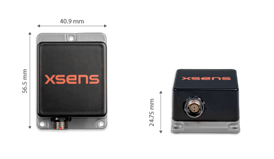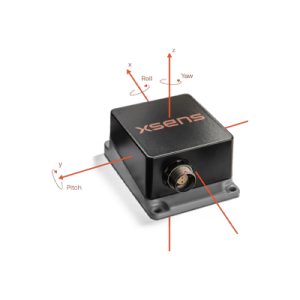Endurance Meets Precision with Xsens Sirius
Inertial sensors are devices that measure motion-related parameters such as velocity, acceleration, orientation, and gravitational forces. These sensors detect changes in the motion state of an object, providing critical data for applications requiring precise motion tracking, navigation, or stabilization.
Inertia describes the tendency of objects to maintain their current state of motion. This means an object will remain completely at rest or continue moving at a constant speed unless acted upon by an external force. If no external force is applied, or the forces applied cancel each other out (resulting in a net force of zero), the object’s state of motion does not change. This principle is known as Newton’s First Law of Motion, also referred to as the law of inertia.
An IMU (Inertial Measurement Unit) is a device that measures how inertia changes in three-dimensional space, based on Newton’s First Law of Motion. It integrates multiple inertial sensors (accelerometers, gyroscopes, and magnetometers) into a single unit. IMUs rely on MEMS (Microelectromechanical Systems) technology, which enables the production of miniaturized mechanical and electronic components on a single chip.
Accelerometer:
Measures linear acceleration along an axis to detect motion, tilt, vibration, and impact. Therefore, IMUs typically contain three accelerometers to enable measurement along three axes.
Gyroscope:
A gyroscope is an inertial sensor that measures angular velocity relative to an inertial reference frame. These sensors measure angular velocity around one or more axes to provide orientation and stability information. MEMS gyroscopes perform this measurement using the Coriolis effect theory, which explains the inertial force acting on a rotating frame within a moving object.
Magnetometer:
A magnetometer measures the direction and strength of magnetic fields. It is often used alongside accelerometers and gyroscopes to provide orientation data. Magnetometers are optional components in IMUs.
With these capabilities, inertial sensors are utilized in various fields such as:
- Automotive
- Consumer electronics
- Robotics
- Defence
- Biomechanics
- Logistics
- Agriculture
- Cinematography
However, some applications involve more challenging environments, requiring higher precision, durability, and reliability. In such demanding conditions, the following needs may arise:
- Aircraft tracking and drone navigation when GNSS data is unavailable.
- Targeting stabilization for cameras and radars.
- Monitoring and maintenance of heavy equipment in construction and mining machinery.
- Autonomous Mobile Robots (AMRs) and Automated Guided Vehicles (AGVs) used for logistics and heavy lifting.
- Accurate 3D orientation data for precision agriculture.
- Obtaining 3D orientation data for Remotely Operated Vehicles (ROVs) and Autonomous Underwater Vehicles (AUVs) in bathymetric mapping.
To meet the high expectations of these applications, Xsens introduced its most advanced series, Sirius. Designed to overcome challenging conditions, Xsens Sirius sets new standards in durability and precision.

The dual-processor design efficiently handles complex calculations, allowing autonomous vehicles to withstand varying and challenging conditions without compromising accuracy.
The signal line, which rejects vibrations and impacts, isolates and eliminates unwanted noise caused by vibrations and shocks using analog filtering. This helps provide real-time data about the condition of machines, preventing costly breakdowns.
Magnetic immunity supports navigation and communication systems of aircraft sensitive to the Earth’s magnetic field or other electromagnetic sources.
The IP68 enclosure, compliant with MIL standards, ensures that this technology can withstand extreme temperatures, humidity, salt, dust, shocks, vibrations, and electromagnetic interference.
The compact plug-and-play design offers easy integration with an extensive software package and a user-friendly SDK (software development kit). It is supported by a robust partner network, including NVIDIA, HESAI, ROS, Matlab, and more.

Xsens Sirius IMU
It is a high-performance sensor that tracks motion and orientation, measuring an object’s rotational speed, acceleration, and the surrounding magnetic field. This IMU ensures that the system responds accurately and consistently in real-time, even in challenging environments.

Xsens Sirius VRU (Vertical Reference Unit)
A VRU is a specialized subset of an IMU, differing in complexity, functionality, and targeted applications. It tracks 3D orientation by measuring the three main movements: roll (tilting), pitch (forward or backward tilting), and yaw (rotation around the vertical axis). Unlike other systems, the Sirius VRU stabilizes on the z-axis and uses the initial position as the 0 reference point. This eliminates the need for external reference points. This simplified approach reduces complexity and cost while providing high-precision, calibrated data.

Xsens Sirius AHRS (Attitude and Heading Reference System)
An AHRS (Attitude and Heading Reference System) is built on an IMU by integrating additional sensors (such as a magnetometer) and advanced computational capabilities, providing highly accurate orientation data. It operates with unique precision. The system delivers performance without drift, providing precise roll, pitch, and true north-referenced yaw data, reducing orientation accuracy to below 1° RMS. This enhanced feature allows the AHRS to determine orientation with exceptional reliability relative to the Earth.

For more information about Xsens Sirius and the Xsens product catalog